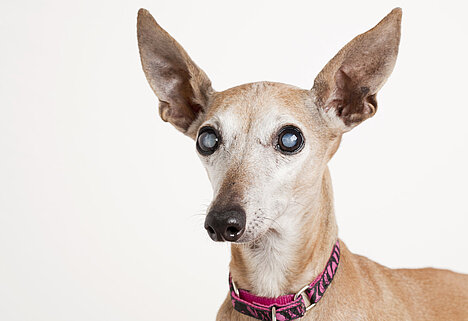Cataracts

Cataracts are an eye disease that can occur in dogs of all breeds and ages. The lens of the eye becomes cloudy, which can lead to impaired or loss of vision. In this blog post, you will learn about the causes, symptoms and treatment options for cataracts in dogs.
What is a cataract?
A cataract is a clouding of the lens that can be caused by various factors. The lens is a clear structure in the eye that refracts light and focuses it on the retina. When the lens becomes cloudy, light can no longer pass through properly and the image becomes blurred or hazy. Cataracts can occur in one or both eyes and can vary in severity.
What are the causes of cataracts?
The most common cause of cataracts in dogs is hereditary predisposition. Some breeds are particularly susceptible to this disease, such as poodles, cocker spaniels, Labrador retrievers and huskies. The hereditary form of cataracts usually occurs at a young or middle age and can deteriorate quickly.
Other possible causes of cataracts are
- Diabetes mellitus: dogs with diabetes have elevated blood sugar levels, which can lead to damage to the lens fibers.
- Age: As some dogs age, age-related changes can develop in the lens, which can lead to a slight clouding. This is also known as lens sclerosis and usually only affects vision slightly.
- Trauma: Injury to the eye from an accident, foreign body or infection can cause inflammation or tearing of the lens, which can lead to cloudiness.
- Nutrition: A lack of certain nutrients, such as vitamin E or C, can lead to a weakening of the lens fibers.
- Medication: Some medications, such as cortisone or certain antibiotics, can cause clouding of the lens as a side effect.
What are the symptoms of cataracts?
The symptoms of cataracts can vary depending on the severity and progression of the disease. The most common signs include:
- A bluish-gray or milky coloration of the pupil
- Reduced visual acuity or blindness
- Increased sensitivity to glare or photophobia
- A change in eye movement or squinting
- Increased tear production or discharge from the eye
- Redness or swelling of the eye
How are cataracts diagnosed?
To diagnose cataracts in your dog, you should consult a vet who will carry out a thorough examination of the eye. Among other things, he will:
- Ask about your dog's medical history to rule out possible risk factors or diseases
- Test your dog's vision, for example by checking their reaction to moving objects or light sources
- Illuminate your dog's eyes with a special lamp (slit lamp) to assess the structure and condition of the lens
- Examine your dog's eyes with a special instrument (ophthalmoscope) to assess the retina and optic nerve
- Measure your dog's intraocular pressure to rule out increased pressure (glaucoma)
How are cataracts treated?
The only effective treatment for cataracts is surgery to remove the cloudy lens and replace it with an artificial lens. This surgery is called cataract surgery and can restore or improve your dog's vision. However, cataract surgery is not suitable for every dog and carries some risks and complications, such as
- An infection or bleeding in the eye
- Inflammation or rejection of the artificial lens
- Retinal detachment or a retinal tear
- Glaucoma or glaucoma
- A renewed clouding of the artificial lens
You should therefore discuss the pros and cons of cataract surgery for your dog with your vet and weigh up whether it makes sense for him. The cost of cataract surgery can vary depending on the vet, region and degree of difficulty, but is usually between 1000 and 3000 euros per eye.
If cataract surgery is not an option for your dog or you decide against it, there are a few ways you can make his life with cataracts easier, for example:
- Keep his environment constant and avoid sudden changes that might confuse or startle him
- Give him clear instructions and signals when you take him for a walk or play with him
- Protect his eyes from direct sunlight or bright light with special glasses or a hat
- Use eye drops or ointments that your vet can prescribe to keep his eyes moist and prevent infection
- Feed him a balanced diet rich in antioxidants and omega-3 fatty acids to support his eye health
Cataracts are a common eye disease in dogs that can lead to visual impairment or blindness. The causes can be varied, but the most common is hereditary predisposition. The symptoms are a bluish-grey or milky coloration of the pupil and reduced visual acuity. Diagnosis is made by a thorough examination of the eye by a veterinarian. Treatment consists of an operation to remove the cloudy lens and replace it with an artificial lens. However, this operation is not suitable for every dog and carries some risks. If surgery is not possible or desired, there are some measures that can make life with cataracts easier.
The authors assume that a veterinarian should be consulted if an animal is ill and that medication should only be taken after consultation with a doctor or pharmacist. Only an individual examination can lead to a diagnosis and treatment decision.
We help you find the nearest vet → This way